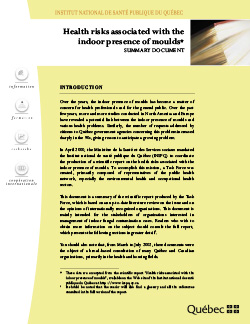Health risks associated with the indoor presence of moulds - Summary document
In April 2000, the Ministère de la Santé et des Services sociaux mandated the Institut national de santé publique du Québec (INSPQ) to coordinate the production of a scientific report on the health risks associated with the indoor presence of moulds. To accomplish this mission, a Task Force was created, primarily composed of representatives of the public health network, especially the environmental health and occupational health sectors.
This document is a summary of the scientific report produced by the Task Force, which is based on an up-to-date literature review on the issue and on the opinions of internationally recognized organizations. This document is mainly intended for the stakeholders of organizations interested in management of indoor fungal contamination cases.
Over the years, the indoor presence of moulds has become a matter of concern for health professionals and for the general public. Over the past few years, more and more studies conducted in North America and Europe have revealed a potential link between the indoor presence of moulds and various health problems. Similarly, the number of requests addressed by citizens to Québec government agencies concerning this problem increased sharply in the 90s, giving reason to anticipate a growing problem.
Given the data gathered by this Task Force, it is appropriate, within a public health perspective, to be concerned about problems of indoor proliferation of moulds and the conditions conducive to their growth. Consequently, the INSPQ Task Force on Moulds believes:
- that a mould-contaminated indoor environment is a risk to the health of the occupants who are exposed, particularly in the case of vulnerable individuals;
- that the frequency and severity of the disorders associated with this risk vary depending on the type of health problem:
- the risk of irritation and non-specific respira-tory symptoms, which are generally slightly to moderately severe, is the risk that most often affects the exposed population;
- the risk of allergic and asthmatic reactions, health problems that may occasionally be severe, only affects subjects predisposed to atopy (allergies);
- hypersensitivity reactions, which are often severe, are at the present time, infrequently reported in residential and non-industrial work settings;
- that the health risk is increased in hospital settings, given the presence of a population at high risk of opportunistic infection. These are rare but often fatal infections. In these circum-stances, the emergency of the response depends on the type of patients, the care sectors and the existence of risky procedures
- that any “fungal contamination” on the surface of building materials or behind them in an indoor environment, as well as any condition conducive to it (e.g. water infiltration, stagnant water, condensation on the building structures) are unac-ceptable situations from a public health standpoint and must therefore be corrected.


